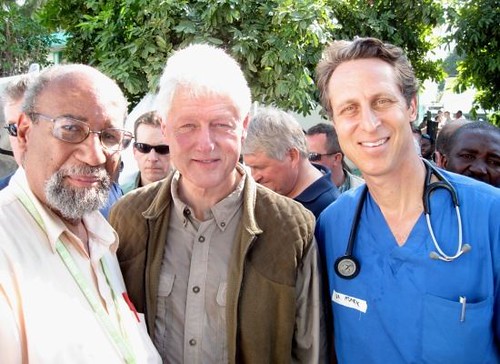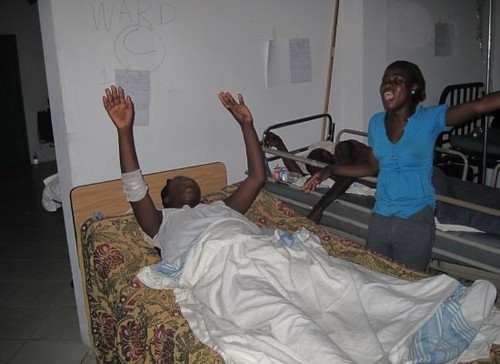Dr. Hyman's Haiti Journal - Day 4: Hacksaws and Vodka

PLEASE NOTE: THIS blog is a reprint of an article that appeared on Huffington Post.
The country has one doctor for 11,000 people. Electricity and running water are available in Port-au-Prince for two hours — on a good day. The chief surgeon at the General Hospital (the largest public national hospital) told me that patients often die in the operating room because the generator fails — on a good day. Under these circumstances, a small group from Partners in Health, led by Paul Farmer, is trying to resurrect the city’s most important hospital from the rubble.
I have been there with a small group of seven surgeons, doctors and nurses who performed the first surgery. That was four days after the quake shook for 15 seconds — flattening the city and over half of the buildings, including the hospital where 150 nurses remain buried in the nursing school. The sickly, sweet stench of death and rotting flesh fills the air as I walk by.
Two orthopedic surgeons, my wife and father in-law, started the first amputation without water, electricity, or disinfectant. They used a rusty hacksaw we washed with vodka, lit by camping headlamps in an empty room with a few boxes of supplies we had packed into our plane. Over the last two days, we created five operating areas to care for the 1,200 patients who are still lying on the ground outside in the hospital’s courtyard. They desperately need surgery to repair their crushed and broken bones, now festering and infected in the humidity and sweltering Haitian sun. The nurses and hospital staff are either dead or at home caring for their families. In the United States we have ten staff for every patient at most hospitals. There now are only a few local staff left for thousands of patients. They, too, are dead. They, too, have lost their homes. Today some began to return to work, their families gone or injured, their homes in piles of rock and debris.
ASSESSING NEEDS AND GETTING ORGANIZED
This morning we stopped at a hardware store on our way to the hospital to find three rusty hacksaws. We are still operating with headlamps and no electricity, oxygen, suction, or cardiac monitoring equipment. It is a week after the earthquake and supplies have spilled into the country from around the world, but much is still at the airport or in processing somehow. This hospital — the main hospital — is not getting the supplies. President Clinton brought what he could today to help but we will run out tomorrow.
There is peace and calm and a sense of gratitude pouring from every bed and every pair of eyes that look at me as I walk by. There is no danger here, no issue of security. There is no need for assessment. There is need for action. We must treat the patients who still can survive, before they need the morgue instead of post-operative care.
At the highest level we need organized and immediate logistical support. We must get everything and everyone to where the need is greatest, especially here at the nation’s main hospital. I received an email from the disaster department (Health and Human Services) stating that they heard from the United Nations that we are fully operational. We are operating, but it is not “operational” yet. People and supplies want to find their way to us (and other places in need) but the dots are not connecting.
SOME PROGRESS
We did have our successes today, under the guidance of Dr. Benjamin, a Haitian-American surgical care intensivist from Mount Sinai. He came down with us on Friday. We turned one of the few remaining safe buildings into a post-operative intensive care unit. At 10 a.m. this morning it was finally clean. By 6 p.m. tonight it was filled with over 50 post-operative patients. They were finally able to be moved from a cramped preoperative room, filled with putrefying wounds, where they had been languishing without care at night.
In three days we have gone from a nearly deserted hospital to a partially-functioning surgical hospital (as well as we can without water or electricity or supplies). Haitian-American surgeons and nurses showed up today to help care for these patients over night, which is the first time there will be any care at night. Our small team of seven has performed 75 operations over the last three days — they now lay behind me, exhausted and asleep. And I can barely keep my eyes open as I write this after nearly three days with no sleep and little food or water.
There are miracles. One girl, whose bed was the back hatch of a Toyota pickup truck, was unstable after we removed her right leg, which had been crushed by the rubble. We left her last night, uncertain if she would survive. But she did. And a sixteen year old girl delivered twins — stillborn in the middle of the night, alone in the dark, groaning from the labor pains and the stabbing pain of her crushed and broken leg.
THE SONGS OF DARKNESS
The preoperative area is dark after sunset, still without electricity as both our main generators broke tonight. There are not enough doctors or nurses to staff it. Patients wait and pray. That is all they can do.
All the NGOs (non-governmental organizations) left because we had no security, even though there has not been one single act of violence or chaos despite the lack of food, water or care for most of the patients. After they left, as I walked into the room to check on the patients, I heard the songs of darkness. The patients and their families sang songs of prayer for strength and courage to bear the burden of suffering through the night. The singing, in unison by patients and their families, filled the darkness. My heart and soul filled with light.
How can a people be so full of love and patience and kindness? And be that way in the midst of unimaginable loss and suffering?
REBUILDING HAITI’S TRAINING HOSPITAL
I received this email from my new friend, Evan Lyon, MD, faculty at the Brigham and Women’s Hospital and a volunteer for Partners in Health. He has worked in Haiti for 10 years. We are trying to coordinate and rebuild the hospital, together with the hospital administration, to create a sustainable, durable institution. This was the Massachusetts General of Haiti, the training site for nearly all its doctors and nurses, and now we have to rebuild it. Today, one of the medical students asked President Clinton how he could help him continue his education, desperate to learn and come back to Haiti to care for his people. We need to help those students finish their training and come back.
Here is what Evan wrote me….
“For over 10 years, Zanmi Lasante has been one of the largest and most attractive training sites for graduating medical students. The majority of our doctors and nurses, our pharmacists and lab technicians, have trained at the Hopital Universite de l’Etat d’Haiti. Until less than a decade ago, all doctors trained in Haiti graduated from the national medical school. This university hospital helped to train them all. We have been honored to receive many of the top graduates of the national university at Zanmi Lasante for their first year out of medical training for a year of social service. Our best medical staff comes from their number and they are leading partners in health’s efforts to respond to the disaster.
The university hospital sustained massive damage; at least 50 percent of the campus cannot be used. Many buildings are destroyed. All are cracked. Some are safe to work in. The adjacent nursing school was completely destroyed. We are working to help the general hospital back to its feet in the dusty shadow of the nursing school where the bodies of many, many second year nursing students remain trapped in the rubble. It will be weeks or months until the rubble is cleared. The smell of death is everywhere. Many of the dead are our sisters and brothers in health, in the difficult work to relieve suffering.
The devastation and sadness of the earthquake are beyond comprehension. Certainly far beyond this single doctor’s heart to see.
Today we worked to get the university hospital on its feet again. Dr. Lassegue, the hospital’s director, and his staff have been ubiquitous at the hospital and are leading efforts to care for the injured. Partners in Health is working closely with the hospital to provide care, and to direct relief efforts from international aid agency’s from around the world. We had five operating rooms operational today. Surgeons had been operating with daylight and flashlights but the electricity is now restored. Over 40 operations were performed today. We estimate over 1,000 are already assessed and awaiting surgery on the campus. People are laying on mats on the ground, on the ground, in shade where it can be found, under sheets strung from the trees.
Inpatient wards are coming together. We hope to increase to 10 operating rooms in the next 48 hours, with 24-hour service now that the electricity has been restored. The hospital must stand again.
As Dr. David Walton and I left the hospital compound this evening, we saw the lights of a large front-end loader working near the morgue. Three dump trucks sat at the ready. Where thousands upon thousands of bodies had laid just days ago, perhaps 40-50 bodies remained: swollen, alone, pushed to the side of the pavement and slippery with blood and body fluids. As we walked past the morgue and the largest pile of bodies, we noticed the one man was wearing a Zamia Asante shirt when he died. I cannot begin to understand why this small detail made a scene of unspeakable sadness even sadder.
We are with all Haitians. This man was with us and is now gone.”
Please donate to Partners in Health at http://www.pih.org. They are integrated with the Haitian health care system and can create a sustainable system from the ashes and sorrow.
Please share your thoughts by leaving a comment below.
To your good health,
Mark Hyman, MD
To see more of Dr. Hyman’s photos from Haiti go to:
http://www.flickr.com/photos/drhyman/sets/72157623158232953/
Beware: Some of the images are graphic.
Related Longevity Articles
Your weekly
wellness newsletters
wellness newsletters
Join my weekly newsletter channels to level up your health with a comprehensive weekly schedule packed with longevity insights, expert interviews, personal picks, and cooking in my kitchen.
Login
- Choosing a selection results in a full page refresh.
- Opens in a new window.









